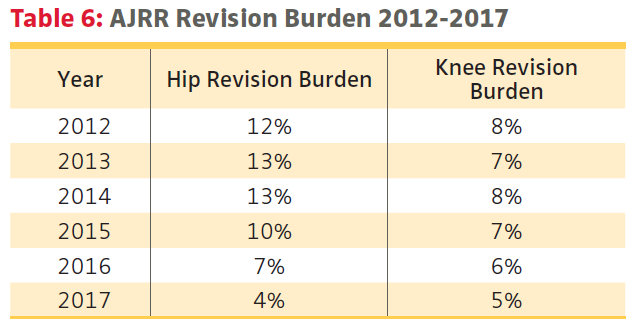
This blog is the final installment in a three-part series reporting on orthopaedic studies presented at the 2019 American Academy of Orthopaedic Surgeons (AAOS) Annual Meeting and utilizing American Joint Replacement Registry (AJRR) registry data. All presentations are reported by Terry Stanton, senior science writer for AAOS Now.
Paper 878, “Correlation of Perioperative Periprosthetic Femur Fractures with Fixation Method” was presented by Bryan D. Springer, MD, vice chair of AJRR, on Friday, March 15, 2019 at the AAOS Annual Meeting in Las Vegas, Nevada. The study evaluated data from the AJRR over a five-year period and analyzed the relationship between femoral stem fixation and perioperative periprosthetic femur fracture (PPFx) requiring early revision total hip arthroplasty (THA) surgery. Analyses determined that cementless femoral fixation accounted for 93 percent of stems with early PPF. Dr. Springer said that patients with cementless stems were 2.6 times more likely to undergo early revision for PPF than those with cemented fixation, although the number of cemented stems in the analyzed population was small, making that finding not statistically significant.
Over the course of the study, 734 participating institutions submitted THA procedural data to AJRR. Data submission was based on a monthly upload of all total joint replacement procedures conducted at that institution during the prior month. AJRR’s database was utilized to identify all primary THAs and hemiarthroplasties performed between 2012 and 2017. Subsequently, the authors sought to identify cases in which the AJRR included both the index arthroplasty and subsequent revision THA (linked revisions). Linkages of primary and revision procedures were confirmed by patient identifiers, including Social Security numbers, procedure site, and laterality.
“It is important to note that not all index procedures are linked to a revision THA, as the revision cases may be performed elsewhere in a hospital either not participating in the Registry or not regularly submitting data to AJRR,” the authors wrote.
The researchers analyzed all early (three months or less from index arthroplasty) linked primary and revision hip arthroplasties to identify revisions that were performed with an accompanying International Classification of Diseases (ICD), Ninth Revision, Clinical Modification (ICD-9) or ICD, tenth revision (ICD-10) diagnosis code of PPF. The authors evaluated patient demographics (age and sex), ICD-9 or ICD-10 procedure code (hemiarthroplasty versus THA), and method of stem fixation (cemented versus cementless). Stem fixation was identified by submitted implant attributes.
There were 10,277 linked revisions reported to AJRR during the study. The most common reasons for failure requiring rTHA were instability/dislocation (13.0 percent) and infection (7.7 percent).
Early periprosthetic femur fracture requiring revision occurred in 628 patients (6.1 percent). Osteoarthritis was the ICD-9 or ICD-10 diagnosis code for the majority (82.4 percent) of the index arthroplasties studied, with femoral neck fracture as the diagnosis for 12.1 percent. Most of the index procedures performed (n = 529, 84.0 percent) were THA, with a small fraction (n = 99, 16.0 percent) being hemiarthroplasty. Fifty-eight percent of patients were aged 70 years and older, and 20 percent were aged 80 years and older. The preponderance of revisions for PPF was in women (70 percent).
Cementless femoral fixation was associated with 94.9 percent (n = 596 versus n = 32) of the periprosthetic fractures. Age, evaluated as a continuous variable, was close to statistical significance, whereas sex was statistically significant. Females were 1.86 times more likely to undergo early revision compared to males.
The authors concluded: “Cementless femoral stem fixation is strongly correlated with increased risk of early periprosthetic femur fracture, and this appears especially true in the female and older population. Despite this and many other reports showing increased risk of periprosthetic femur fracture, it remains the overwhelmingly dominant mode of fixation for hip arthroplasty in those centers reporting to the AJRR. Clearly defining risk factors and indications for cemented or cementless fixation should be a priority to reduce the incidence of this complication.”
Dr. Springer noted that this study and others deriving data from the AJRR demonstrate the value of the Academy-sustained registry. “Although in its infancy from a national registry standpoint, the AJRR is now the largest registry in the world by procedural volume,” he said. “Registry data give a representative sample of practices and trends across the country. In addition, as the Registry grows, we will be able to evaluate more granular data and determine best practice benchmarks.”
If you have any additional questions about the study, feel free to contact us at RegistryInfo@aaos.org.
Dr. Springer’s coauthors of “Perioperative Periprosthetic Femur Fractures Are Strongly Correlated with Fixation Method: An Analysis from the American Joint Replacement Registry (AJRR)” are Caryn D. Etkin, PhD, MPH; Peter B. Shores, MPH; Terence J. Gioe, MD; David G. Lewallen, MD; and Kevin J. Bozic, MD, MBA.
For information about the AAOS RegistryInsights platform, speak with a Registry Engagement Associate at (847) 292-0530 or Request A Demo today!
Be sure to leave a comment in the form below!



